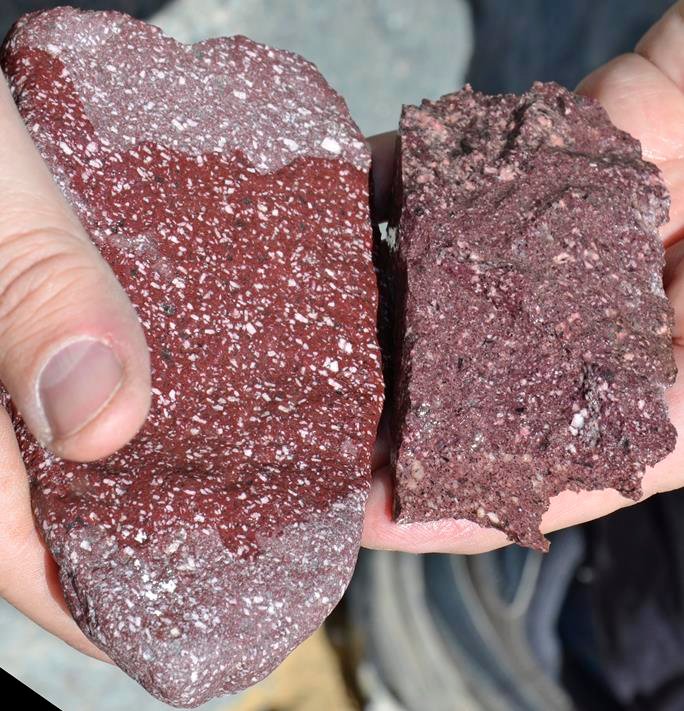Purple, red, or Roman Imperial porphyry refers to reddish to purplish porphyritic rocks highly-priced during the antiquity age by Romans and Byzantines.
These rocks came to Jabal Dukhan in the Eastern Desert of Egypt and were used for artwork and building exclusively for the imperial court of the Roman Empire.
Porphyry describes igneous rocks with large, well-formed crystals called phenocrysts set in a finer-grained matrix called groundmass.
Such a rock will have two distinctive grain sizes, i.e., bimodal grain sizes. The resultant texture is known as porphyritic texture.
How do they form? These rocks form from mostly two-stage cooling. A slow stage deep inside the Earth’s crust that forms phenocrysts and a faster one that forms the groundmass. However, stones with such a texture can form in other ways, too.
Lastly, the Imperial porphyries were also known as the Red Porphyry of Egypt and porfido rosso antico or Ancient Red Porphyry. Their other name was porphyrites leptosephos by Italian sculptors during classical times.

Where did Imperial Porphyry come from?
Imperial porphyry rocks were mined at Mons Porphyritic on the northern part of Jabal Dukhan. Jabal Dukhan is a 40 km interior of the Red Sea and Gulf of Suez Canal junction and about 80 km from the River Nile.
They were discovered by Caius Cominius Leugas, a Roman explorer, and occurred in a shallow, sill-like subvolcanic, which is a member of the Dokhan volcanic suite.
These rocks were quarried from the Roman Iron Age, about AD 18, to the middle of the 5th century, during the Roman Empire’s occupation of Egypt.
During this period, thousands of workers mined and transported these rocks to the Nile en route to the imperial city of Rome.
What rocks were the Roman Imperial porphyry?
Roman Imperial porphyry stones were compositionally trachyandesite to dacite porphyritic rocks.
Trachyandesites are fine-grained, intermediate volcanic or igneous rocks whose composition lies between andesite and trachyte. They have mainly alkali feldspar and sodium-rich plagioclase with little or no quartz.
On the other hand, dacite is a fine-grained, felsic igneous rock. It mainly has plagioclase feldspar and quartz with a smaller amount of alkali feldspar, biotite, hornblende, and a few other mafic minerals.
Depending on the variety, these rocks have large white or pink feldspar phenocrysts in a fine-grained deep purple, purple, or greenish-tinged black matrix.
The main varieties are:
1. Lapis porphyrites – purple Imperial Porphyry
Lapis porphyrites were porphyritic dacite with white feldspars set in a deep purple, finely-grained groundmass of mainly brown feldspar. The purplish color was due to the presence of dispersed, purple-colored flakes of hematite.
The white feldspar phenocrysts occurred singly or as aggregate. Also, this rock had amphibole glomeroporphyritic aggregate phenocrysts.
Besides the feldspar and hematite, the groundmass sometimes has quartz, manganese bearing pink epidote, apatite, titanite, pink piemontite, and other minerals.
2. Rubet porphyrites (red)
This variety had pink or whitish feldspar phenocrysts in a finely crystalline reddish-purple or purplish-red groundmass. The inclusion of pink piemontite gave the groundmass a reddish-purple color.
3. Lapis porphyrites Niger
This dacite variety has white or grey feldspars in the groundmass that appear black with a greenish tinge. This blackish groundmass has finely crystalline feldspar and greenish or brownish hornblende.
In this rock, amphibole phenocrysts were uncommon, while the groundmass also had epidote, quartz, and rarely titano-magnetite.
What were the uses of Imperial Porphyry?
The Roman Imperial porphyry was used to make artworks, ornamental items, and architectural elements for only the imperial court of the Roman Empire.

A brecciated variety of the Imperial Porphyry was particularly more valued. It made fine works of art.
Why was it valued? This rock was particularly valued due to its purple color. This color was associated with or represented a symbol of imperial status.
Some of the architectural elements and artwork that imperial porphyry made include monolithic columns, pedestals, mantle pieces, sculptures, giant bowls, ceremonial bathtubs, etc.
Their use in Pharaonic Egypt was rare. However, they occasionally made small plates and sculptures.
For instance, the British Museum in Bloomsbury, London, has emperor Hadrian’s carving made with Egyptian porphyry. This carving was made about AD 130 using copper tools fed with emery and sand.
Lastly, to give it a great appearance, items or building elements made with this rock were skillfully finished to provide a sparkling appearance to the feldspar phenocrysts.
